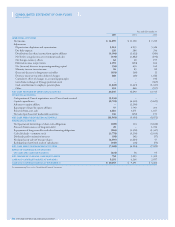Chevron 2005 Annual Report Download - page 60
Download and view the complete annual report
Please find page 60 of the 2005 Chevron annual report below. You can navigate through the pages in the report by either clicking on the pages listed below, or by using the keyword search tool below to find specific information within the annual report.
58 CHEVRON CORPORATION 2005 ANNUAL REPORT
NOTE 1.
SUMMARY OF SIGNIFICANT ACCOUNTING POLICIES
General Chevron manages its investments in and provides
administrative, fi nancial and management support to U.S.
and foreign subsidiaries and affi liates that engage in fully
integrated petroleum and chemicals operations. In addi-
tion, Chevron holds investments in businesses involving
power generation, geothermal production, and the mining
of coal and other minerals. Collectively, these companies
conduct business activities in approximately 180 countries.
Exploration and production (upstream) operations consist of
exploring for, developing and producing crude oil and natu-
ral gas and also marketing natural gas. Refi ning, marketing
and transportation (downstream) operations relate to refi ning
crude oil into fi nished petroleum products; marketing crude
oil, natural gas and the many products derived from petro-
leum; and transporting crude oil, natural gas and petroleum
products by pipeline, marine vessel, motor equipment and
rail car. Chemical operations include the manufacture and
marketing of commodity petrochemicals, plastics for indus-
trial uses, and fuel and lubricant oil additives.
The company’s Consolidated Financial Statements are
prepared in accordance with accounting principles gener-
ally accepted in the United States of America. These require
the use of estimates and assumptions that affect the assets,
liabilities, revenues and expenses reported in the fi nancial
statements, as well as amounts included in the notes thereto,
including discussion and disclosure of contingent liabilities.
Although the company uses its best estimates and judgments,
actual results could differ from these estimates as future con-
fi rming events occur.
The nature of the company’s operations and the many
countries in which it operates subject the company to changing
economic, regulatory and political conditions. The company
does not believe it is vulnerable to the risk of near-term severe
impact as a result of any concentration of its activities.
Subsidiary and Affiliated Companies The Consolidated Finan-
cial Statements include the accounts of controlled subsidiary
companies more than 50 percent owned and variable interest
entities in which the company is the primary benefi ciary.
Undivided interests in oil and gas joint ventures and certain
other assets are consolidated on a proportionate basis. Invest-
ments in and advances to affi liates in which the company has
a substantial ownership interest of approximately 20 percent
to 50 percent or for which the company exercises signifi cant
infl uence but not control over policy decisions are accounted
for by the equity method. As part of that accounting, the
company recognizes gains and losses that arise from the issu-
ance of stock by an affi liate that results in changes in the
company’s proportionate share of the dollar amount of the
affi liate’s equity currently in income. Deferred income taxes
are provided for these gains and losses.
Investments are assessed for possible impairment when
events indicate that the fair value of the investment may be
below the company’s carrying value. When such a condition
is deemed to be other than temporary, the carrying value
of the investment is written down to its fair value, and the
amount of the write-down is included in net income. In
making the determination as to whether a decline is other
than temporary, the company considers such factors as the
duration and extent of the decline, the investee’s fi nancial
performance, and the company’s ability and intention to
retain its investment for a period that will be suffi cient to
allow for any anticipated recovery in the investment’s mar-
ket value. The new cost basis of investments in these equity
investees is not changed for subsequent recoveries in fair
value. Subsequent recoveries in the carrying value of other
investments are reported in “Other comprehensive income.”
Differences between the company’s carrying value of an
equity investment and its underlying equity in the net assets
of the affi liate are assigned to the extent practicable to specifi c
assets and liabilities based on the company’s analysis of the
various factors giving rise to the difference. The company’s
share of the affi liate’s reported earnings is adjusted quarterly
when appro priate to refl ect the difference between these allo-
cated values and the affi liate’s historical book values.
Derivatives The majority of the company’s activity in com-
modity derivative instruments is intended to manage the
fi nancial risk posed by physical transactions. For some of
this derivative activity, generally limited to large, discrete
or infrequently occurring transactions, the company may
elect to apply fair value or cash fl ow hedge accounting. For
other similar derivative instruments, generally because of
the short-term nature of the contracts or their limited use,
the company does not apply hedge accounting, and changes
in the fair value of those contracts are refl ected in cur-
rent income. For the company’s trading activity, gains and
losses from the derivative instruments are reported in cur-
rent income. For derivative instruments relating to foreign
currency exposures, gains and losses are reported in cur-
rent income. Interest rate swaps – hedging a portion of the
company’s fi xed-rate debt – are accounted for as fair value
hedges, whereas interest rate swaps relating to a portion of
the company’s fl oating-rate debt are recorded at fair value
on the Consolidated Balance Sheet, with resulting gains and
losses refl ected in income.
Short-Term Investments All short-term investments are
classifi ed as available for sale and are in highly liquid
debt securities. Those investments that are part of the
company’s cash management portfolio and have original
maturities of three months or less are reported as “Cash equiv-
alents.” The balance of the short-term investments is reported
as “Marketable securities” and are marked-to-market, with
NOTES TO THE CONSOLIDATED FINANCIAL STATEMENTS
Millions of dollars, except per-share amounts
























